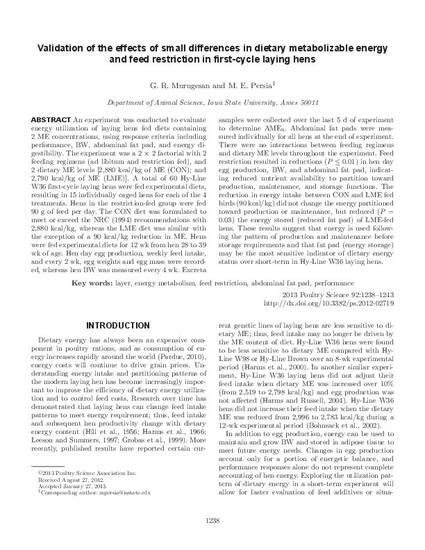
Article
Validation of the effects of small differences in dietary metabolizable energy and feed restriction in first-cycle laying hens
Poultry Science
(2013)
Abstract
An experiment was conducted to evaluate energy utilization of laying hens fed diets containing 2 ME concentrations, using response criteria including performance, BW, abdominal fat pad, and energy digestibility. The experiment was a 2 × 2 factorial with 2 feeding regimens (ad libitum and restriction fed), and 2 dietary ME levels [2,880 kcal/kg of ME (CON); and 2,790 kcal/kg of ME (LME)]. A total of 60 Hy-Line W36 first-cycle laying hens were fed experimental diets, resulting in 15 individually caged hens for each of the 4 treatments. Hens in the restriction-fed group were fed 90 g of feed per day. The CON diet was formulated to meet or exceed the NRC (1994) recommendations with 2,880 kcal/kg, whereas the LME diet was similar with the exception of a 90 kcal/kg reduction in ME. Hens were fed experimental diets for 12 wk from hen 28 to 39 wk of age. Hen day egg production, weekly feed intake, and every 2 wk, egg weights and egg mass were recorded, whereas hen BW was measured every 4 wk. Excreta samples were collected over the last 5 d of experiment to determine AMEn. Abdominal fat pads were measured individually for all hens at the end of experiment. There were no interactions between feeding regimens and dietary ME levels throughout the experiment. Feed restriction resulted in reductions (P ≤ 0.01) in hen day egg production, BW, and abdominal fat pad, indicating reduced nutrient availability to partition toward production, maintenance, and storage functions. The reduction in energy intake between CON and LME fed birds (90 kcal/kg) did not change the energy partitioned toward production or maintenance, but reduced (P = 0.03) the energy stored (reduced fat pad) of LME-fed hens. These results suggest that energy is used following the pattern of production and maintenance before storage requirements and that fat pad (energy storage) may be the most sensitive indicator of dietary energy status over short-term in Hy-Line W36 laying hens.
Keywords
- Layer,
- Energy metabolism,
- Feed restriction,
- Abdominal fat pad,
- Performance
Disciplines
Publication Date
May, 2013
DOI
https://doi.org/10.3382/ps.2012-02719
Citation Information
G. R. Murugesan and M. E. Persia. "Validation of the effects of small differences in dietary metabolizable energy and feed restriction in first-cycle laying hens" Poultry Science Vol. 92 Iss. 5 (2013) Available at: http://works.bepress.com/raj_murugesan/3/
